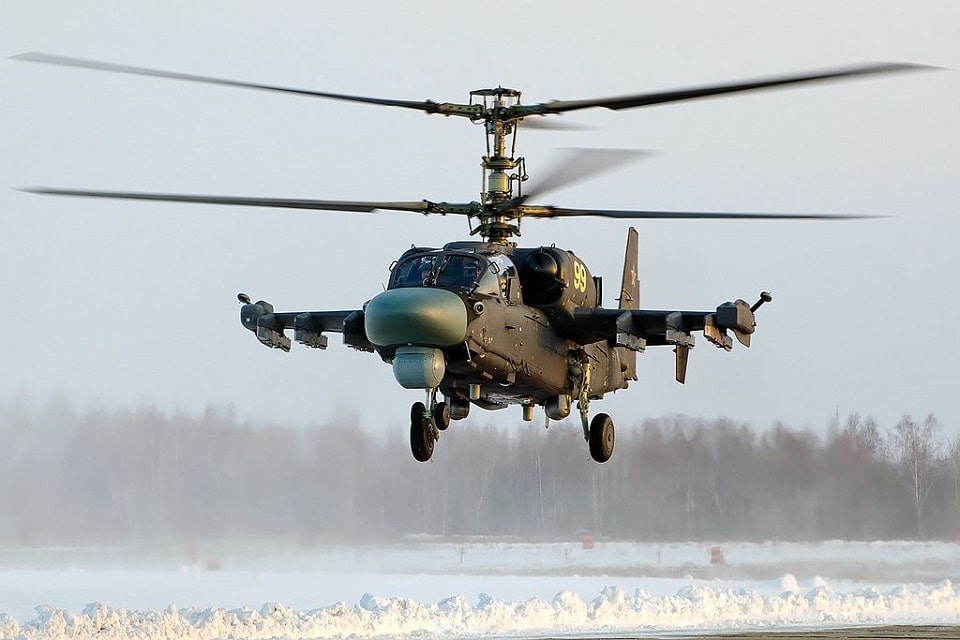Aerospace
10 interesting facts about Ka-52 helicopter

The Ka-52 helicopter, popularly known as the “Alligator,” is a powerful attack helicopter built and manufactured by Russian company Kamov. The Ka-52 is built to excel in close air support and anti-tank warfare tasks with its distinctive coaxial rotor system, cutting-edge avionics, and weapons. Here are ten amazing facts about this impressive aircraft.
Mi-28NE and Ka-52 to participate at Dubai Airshow 2021(Opens in a new browser tab)
1.The Ka-52 made its first flight on June 25, 1997, and entered service with the Russian military in 2011. It is primarily operated by the Russian Army Aviation.
2.The Ka-52 is primarily made for close air support and anti-tank operations. It is capable of targeting armored vehicles, hostile helicopters, and ground targets with its extensive arsenal of armaments, which also includes guided missiles, rockets, and a 30mm cannon.
3. The Ka-52 is equipped with cutting-edge avionics and sensor technology that allow it to fly in bad weather and at any time of day. Infrared sensors, a helmet-mounted display, and a long-range target acquisition system are all included in it, which gives the crew better situational awareness.
4. One unique feature of the Ka-52 is its ejection seats. In emergency situations, both the pilot and co-pilot can eject safely from the helicopter. The seats are equipped with rocket-assisted ejection systems, and each crew member has a separate ejection mechanism.
5. The helicopter’s cockpit is protected by armour and can survive bullet splinters and small weapons fire. Additionally, it features ejection seats, which can be used to protect the crew during situations at low altitudes and low airspeeds.
6. The Ka-52 has a self-defense package that comprises flares and chaff to deflect incoming missiles, radar and laser warning systems, and other defenses. With external fuel tanks, it has an approximate range of 1,100 kilometers (680 miles) and a top speed of about 300 kilometers per hour (186 miles per hour).
7. The Ka-52 is outfitted with improved night vision and targeting systems, allowing it to operate well in low-light circumstances. It detects and engages targets using thermal imaging and infrared sensors, giving it a substantial edge in nighttime operations and improving its combat mobility.
10 fastest Military helicopters in the world ..!!(Opens in a new browser tab)
8. It has a maximum takeoff weight of roughly 12,000 kg (26,455 lbs) and can carry external weights of up to 2,000 kg (4,409 lbs). It allows aircraft to deliver a variety of payloads, such as ammunition, fuel, and additional equipment.
9. The helicopter is frequently utilized by the Russian military and has seen combat in situations such as the Syrian Civil War. Its distinct features and capabilities make it a powerful asset in both attack and reconnaissance missions.
10. The helicopter’s unusual counter-rotating rotor blades provide high lift efficiency, allowing it to hover and maneuver in tight places. It has a high level of survivability, with armoured protection for essential components, redundant systems, and self-sealing fuel tanks.

Aerospace
Boeing Transfers Rocket Stage to NASA, Paving Way for Human Moon Mission

Boeing has achieved a significant milestone by providing NASA with the second core stage of the Space Launch System (SLS) rocket.
This crucial component, crafted at NASA’s Michoud Assembly Facility (MAF), is set to propel the Artemis II crew into lunar orbit, marking humanity’s return to deep space after a 50-year hiatus.
The monumental Boeing-built rocket stage, the largest element of the Artemis II mission, will embark on a journey aboard the Pegasus barge, traveling 900 miles to NASA’s Kennedy Space Center.
Comparison of two legendary aircraft B777x vs B747 aircraft:Click here
Upon arrival, it will be meticulously integrated with other essential Artemis II components, including the upper stage, solid rocket boosters, and NASA’s Orion spacecraft within the iconic Vehicle Assembly Building. This intricate integration process is a vital step toward the eagerly anticipated Artemis II launch, slated for 2025.
“Boeing-built products helped land humankind on the moon in 1969, and we’re proud to continue that legacy through the Artemis generation,” remarked Dave Dutcher, vice president and program manager for Boeing’s SLS program. “Together, with NASA and our industry partners and suppliers, we are building the world’s most capable rocket and paving the way to deep space through America’s rocket factory in New Orleans.”
NASA, Lockheed Martin Reveal X-59 Quiet Supersonic Aircraft:Click here
The delivery of Core Stage 2 marks a significant achievement in the evolution of the SLS rocket. Towering over 200 feet and powered by four RS-25 engines, this core stage, coupled with two solid-fueled booster rockets, will generate a staggering 8.8 million pounds of thrust. This immense power is crucial to launching Artemis II and future missions into the vast expanse of space.
The SLS rocket stands unparalleled in its capability to transport both crew and substantial cargo to the moon and beyond in a single launch. Its extraordinary capacity will facilitate the delivery of human-rated spacecraft, habitats, and scientific missions to destinations including the moon and Mars, ushering in a new era of space exploration.
-

 Travel1 week ago
Travel1 week agoAir India to Expand US Operations with Three New Routes After a Decade
-

 Travel2 weeks ago
Travel2 weeks agoWhy We Should Avoid These Stamps in a Passport
-

 Airlines1 month ago
Airlines1 month agoInvestigations Reveal Fake Chinese Titanium in Boeing and Airbus Jets
-

 Tech4 weeks ago
Tech4 weeks agoChina’s CATL Plans 1,800-Mile Electric Plane Launch by 2027
-

 Airport3 days ago
Airport3 days agoTop 10 Largest Airports in the World by Size
-

 Aerospace4 weeks ago
Aerospace4 weeks agoChina’s Fighter Jets Turn Wings into Autonomous Drones
-

 Airlines4 days ago
Airlines4 days agoAir India Rolls Out A350s for Delhi-New York JFK and Newark Routes
-

 Defence3 weeks ago
Defence3 weeks agoBoeing Enhances Chinook with New Engines and Block II Upgrades at $96 Million







